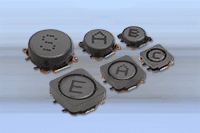source: Vishay news
MALVERN, Pa. — Apr. 10, 2017 — Vishay Intertechnology, Inc. (NYSE: VSH) today introduced two new series of low profile power inductors optimized for DC/DC conversion in portable electronics. Offered in compact 1212, 1616, and 2020 case sizes with low profiles down to 1.0 mm, Vishay Dale IFL and IFLS series devices deliver inductance up to 100 µH — values normally reserved for larger components.
With their small size, high inductance values, and frequencies up to 5 MHz, the devices released today provide a space-saving solution for notebooks, desktop PCs, and servers; low profile, high current power supplies and point of load (POL) converters; and DC/DC converters for distributed power systems and FPGAs.
IFL and IFLS series devices feature a ferrite core with polyurethane enameled copper wire and an epoxy resin adhesive. The non-shielded IFL series offers typical DCR from 42 mΩ to 2460 mΩ and high rated saturation current to 7.5 A. The shielded IFLS series protects nearby components from magnetic radiation, while providing typical DCR from 43 mΩ to 1730 mΩ and rated current to 3.8 A. All devices are RoHS-compliant and operate over a temperature range of -40 °C to +105 °C.
Device Specification Table
| Part # | IFL-1212AZ | IFL-1616AE | IFL-2020BZ | IFLS-1212AB | IFLS-1616AE | IFLS-2020BZ |
| Case size | 1212 | 1616 | 20202 | 1212 | 1616 | 2020 |
| Profile (mm) | 1.0 | 1.5 | 2.0 | 1.2 | 1.5 | 2.0 |
| Inductance (µH) | 1.0 to 22 | 1.0 to 100 | 0.47 to 100 | 1.0 to 33 | 1.0 to 100 | 1.0 to 68 |
| DCR typ. (mΩ) | 64 to 1000 | 48 to 2460 | 42 to 1440 | 55 to 1210 | 43 to 1730 | 43 to 650 |
| DCR max. (mΩ) | 77 to 1200 | 58 to 2952 | 50 to 1728 | 66 to 1452 | 52 to 2076 | 52 to 780 |
| Heat rating current (A) | 0.40 to 1.70 | 0.25 to 1.85 | 0.40 to 2.60 | 0.25 to 1.80 | 0.30 to 2.30 | 0.50 to 2.60 |
| Saturation current (A) | 0.33 to 1.50 | 0.33 to 3.60 | 0.55 to 7.50 | 0.26 to 1.50 | 0.27 to 2.30 | 0.46 to 3.80 |
| Shielded | No | No | No | Yes | Yes | Yes |
Samples and production quantities of the IFL and IFLS series inductors will be available in Q1 2017, with lead times of 10 weeks for large orders.































